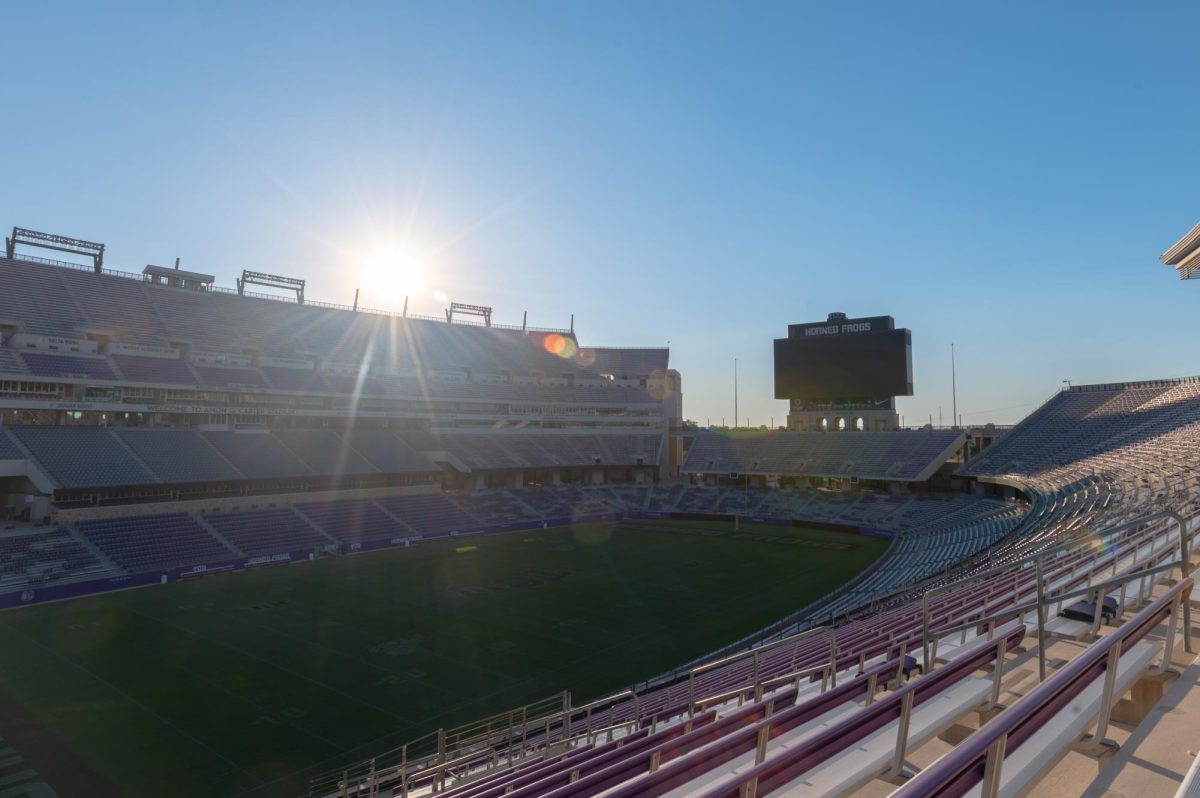Echoes of squealing laughter can be heard as children race around the room. Pool balls clack together and fruit snack wrappers crumble as elementary students holler and giggle excitedly. Scribbling thoughtfully, a 9-year-old girl named Courtney jots down lyrics to a song she hopes will make it on the radio and swoon her secret crush. Meanwhile, a pair of boys furiously spin plastic soccer players in a competitive foosball match. Life is normal inside the walls of the Boys and Girls Club of Greater Fort Worth, a daycare center serving at-risk youths ages six to eighteen. Outside, however, is another story. Just a block away is East Lancaster Avenue, an area plagued by severe poverty and crime. According to NeighborhoodScout, its income is lower than 99 percent of all U.S. cities and 89.3 percent of children here fall below the federal poverty line. Ashton Douglas, the club’s operations support specialist, said the Lancaster area has been a notoriously unsafe area for some time. Below is a map charting crimes reported near the Boys and Girls Club between Sept. 28 and Oct. 18 2016. Information is courtesy of crimemapping.com. Public housing adjacent to the club is where most of the children call home, Douglas said. She said families living inside these weathered brick units are often single-parent households and 77 percent of them below the poverty line. Annual incomes here typically don’t exceed $10,000. According to the Boys and Girls Club 2015 Needs Assessment, the club reported that 63 percent of members have had a family member incarcerated and 53 percent come from a single-parent household. Douglas said gang activity is common near these neighborhoods. She said it is a predominantly Crip-affiliated area. “It’s bizarre to me to know that these kids are growing up in an area where gang violence is so normal to them,” Douglas said. Many of the children living here don’t have the means to spend their free time far from their impoverished homes and have nowhere else to go. The Boys and Girls Club is a silver lining, an oasis in a barren ocean. Douglas said she wants to show these children that there’s more out there for them than this. “That’s what’s important about the Boys and Girls Club is that it gives kids a place to go that’s safe,” Douglas said. LeCharles Green, the branch director of the club, talked about how their day care is a neutral territory within the neighborhood. He told a story about how a stranger once warned all the children to stay inside before, what Green figured, something bad happened nearby. Green said it was comforting to know that while it’s in a “rough area,” the day care has people looking out for its members.  Most of these young members walk straight to day care from the neighboring school, I.M. Terrell Elementary. For the next four hours, the children learn, play and bond. After a half hour of game time, the children are separated by age group rotate between the education, art and game room. Education is heavily emphasized to club members. Douglas said they have “power hour” where the young students work on their homework and can receive extra help from education specialists. She said their programs also teach literacy, math and science. The needs assessment report stated that children living in low-income homes tend to perform poorly on standardized tests. It said test scores are directly tied to income and education levels of the parents. James Newson, the chief operations officer, said many of the parents haven’t graduated from high school or college and may not stress education to the children. He said it’s a “double whammy” for the students enrolled in low-performing schools. “The cards are stacked against the kids,” Newson said. “We want to change the odds.” They’re also given a snack and served dinner every day as food may not always be readily available to them at home. Twenty-six percent of Tarrant County children don’t have consistent access to food, according to the 2016 State of Texas Children report. The report also said hunger can lead to development issues in learning, behavior and fitness. Newson said hunger is an issue for a lot of their members. He said many times children will try to take food they’re given at the day care back home to younger siblings who don’t yet qualify for club membership. At the end of the day, Newson said, the day care is a safe place for them to have fun. “They’re amazing kids,” he said. “They’re resilient. Even with all their challenges they can still be kids and surprise you every day.” There are eight club sites in Tarrant County caring for about 11,000 children. Each are setup in low-income areas where there are children who need these communities the most.
Most of these young members walk straight to day care from the neighboring school, I.M. Terrell Elementary. For the next four hours, the children learn, play and bond. After a half hour of game time, the children are separated by age group rotate between the education, art and game room. Education is heavily emphasized to club members. Douglas said they have “power hour” where the young students work on their homework and can receive extra help from education specialists. She said their programs also teach literacy, math and science. The needs assessment report stated that children living in low-income homes tend to perform poorly on standardized tests. It said test scores are directly tied to income and education levels of the parents. James Newson, the chief operations officer, said many of the parents haven’t graduated from high school or college and may not stress education to the children. He said it’s a “double whammy” for the students enrolled in low-performing schools. “The cards are stacked against the kids,” Newson said. “We want to change the odds.” They’re also given a snack and served dinner every day as food may not always be readily available to them at home. Twenty-six percent of Tarrant County children don’t have consistent access to food, according to the 2016 State of Texas Children report. The report also said hunger can lead to development issues in learning, behavior and fitness. Newson said hunger is an issue for a lot of their members. He said many times children will try to take food they’re given at the day care back home to younger siblings who don’t yet qualify for club membership. At the end of the day, Newson said, the day care is a safe place for them to have fun. “They’re amazing kids,” he said. “They’re resilient. Even with all their challenges they can still be kids and surprise you every day.” There are eight club sites in Tarrant County caring for about 11,000 children. Each are setup in low-income areas where there are children who need these communities the most.
Categories:
Boys and Girls Club of Greater Fort Worth offers children refuge in impoverished neighborhoods
By Shane Battis
Published Oct 25, 2016



